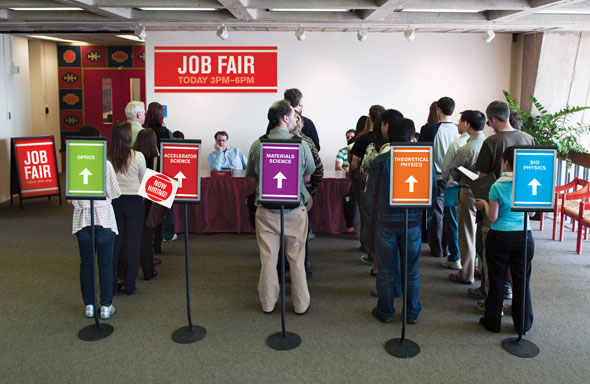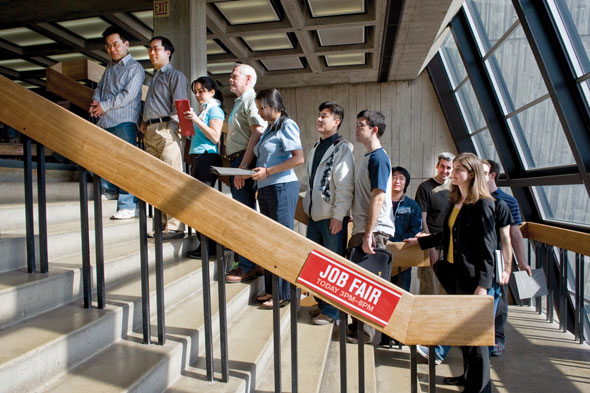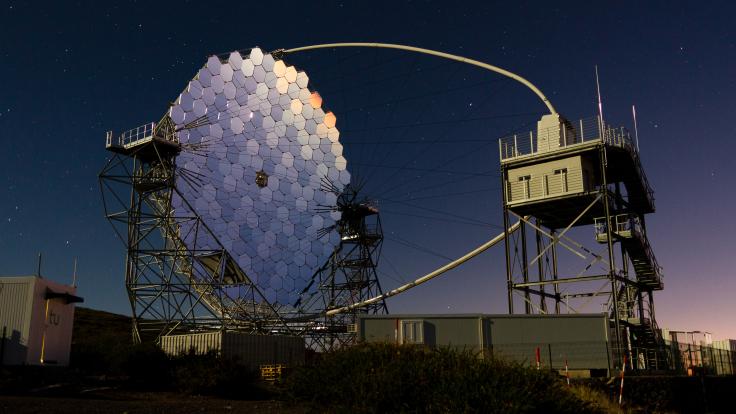A field where jobs go begging
With a growing demand for particle accelerators in science, medicine, and industry, accelerator science is in desperate need of skilled specialists.
By Chris Knight
 |
| Photos: Reidar Hahn, Fermilab |
Tony Favale is looking to hire.
Business in the particle accelerator world is booming, as is business at Advanced Energy Systems, where Favale is president. His company, with offices in New York and New Jersey, is doing research and design work for the next generation of accelerators, which will be employed in electron lasers for the Navy, radiation detectors for the Department of Homeland Security, and more efficient particle colliders at US national laboratories.
But of the seven positions he was advertising in November, three were still unfilled in mid-March because Favale cant find enough qualified accelerator scientists. The shortage is forcing the scientists and engineers he already employs to work overtime. Favale isnt picky; he says hed be comfortable hiring people with experience in other fields, such as vacuum or radio-frequency technology, and teaching them the accelerator science on the job.
"Anybody thats got any of these talents, one of the industries will pick them up tomorrow, so the competition is rough," Favale says. "Right now everyone is fighting for the same people."
Renewed government investment in accelerators, combined with a growing number of medical and industrial applications, has produced a flood of design, engineering, research, and development work on the current and next generation of accelerator projects.
Yet of the 5915 physics PhDs awarded in the United States in the last five years, only 54 went to people who identified themselves as accelerator physicists, says Roman Czujko, director of the American Institute of Physics Statistical Research Center. This number does not account for the many physicists who switch to accelerator science later in their careers.
The shortage is likely to get worse before it gets better, scientists say. The next generation of proposed projects presents unique technical challenges that will raise demand for accelerator scientists, all while industry recruits top scientists away from national laboratories. Speaking at the Symposium on Accelerators for Americas Future in Washington, DC, in October, William Barletta, a physics professor at the Massachusetts Institute of Technology, said expanding the accelerator-scientist workforce in the United States is essential.
"These machines are conceived of, designed, built, operated, and upgraded by a few hundred accelerator physicists, a large fraction of them trained outside the US," Barletta said.
Thinning ranks
At the same time, a significant portion of the workforce of trained accelerator scientists is nearing retirement. SLAC National Accelerator Laboratory in California, for instance, will have to replace an estimated 15 to 20 percent of its accelerator scientists in the next decade because of retirements, says David MacFarlane, associate lab director for particle physics and astrophysics.
Only a trickle of younger scientists is coming in to replace those who retire, says Maury Tigner, an accelerator physicist at Cornell University.
"Even if all of the accelerator scientists lived forever," Tigner says, "we would still be in a deficit situation."
Accelerator science straddles physics, engineering, and many other specialties, so those entering the field come from a variety of backgrounds. But with no set path or certification for the profession, it is difficult to determine how many accelerator scientists work in the United States or how many more are necessary.
Barletta says organizers at the United States Particle Accelerator School will begin a study later this year to quantify the future needs for accelerator-based science in the United States.
"We all say that education is important and that wed like to train more accelerator scientists, but thats not helpful to those who have the funding to make this happen," he says. "They need us to tell them how many scientists we need and why."
A broad, complex technology
Most discoveries in particle physics come from detectors, huge devices surrounding the point where a particle beam hits a static target or two beams smash into each other. Layers of sensitive electronics detect the debris from these collisions; then experimental physicists use that data to discover new particles.
But behind every big detector is a much, much larger machine that accelerates the subatomic particles, gradually ramping up the energies of the beams toward an eventual collision.
Designing, researching, building, and operating these huge machines is the domain of accelerator scientists. Accelerators today use so many types of technology, from superconducting magnets to high-powered vacuums, that accelerator science is a broad, diverse field with many specialties.
Some accelerator scientists research and develop technology for next-generation accelerators, while others tweak existing machines. With thousands of magnets and power supplies, extremely cold temperatures, high amounts of electricity, and the wear and tear associated with round-the-clock operations, accelerators present difficult problems that demand custom solutions.
Accelerators used for high-energy physics receive the most attention, but represent only about one percent of the estimated 30,000 accelerators used worldwide in industry and medicine, all of which need the expertise of accelerator scientists throughout development.
A field emerges
As accelerators have evolved to become more complex, so has the training needed to design, build, and run them.
Early accelerators were often built and operated by students fresh out of graduate school. Alvin Tollestrup was one of those students. After graduating from the California Institute of Technology in 1946, his first job was to build a device to inject particles into Caltechs synchrotron, which at the time was on track to become the worlds highest-energy synchrotron at 1 million electronvolts. A few years later, the accelerator was operational and taking data, a timeline that would now be impossibly ambitious given the scale and complexity of todays machines.
"These machines have become so complicated that they have to be divided up into individual areas of expertise," says Tollestrup, who is now a scientist at Fermi National Accelerator Laboratory in Illinois. "Now theres an enormous split between the fields. You dont have the time to understand all those things in a lifetime."
This specialization in accelerator science began, Tollestrup says, when a change in magnet design allowed designers to boost the energies of accelerators from about 3 billion electronvolts in the 1950s to about 33 billion electronvolts in the 1960s. The new, high-powered machines were so much more complicated that they required a decade of planning before the first shovel broke ground.
Slow, careful tweaks at nearly light speed
Today, making a single change to an operating accelerator can take years. In Bob Zwaskas case, it took three.
Working at Fermilab, Zwaska needed to find a way to smash more protons into a fixed target that generates neutrinos. Neutrinos are particles with almost no mass that can travel through hundreds of miles of solid earth without ever interacting with other matter.
The initial neutrino-generating setup at Fermilab worked in batches. First an accelerator called the Booster ring would speed up a batch of protons. Then the protons would head off to a much larger accelerator called the Main Injector, where they would gain more speed and head off to be smashed. The smaller Booster ring only partially filled the larger Main Injector, making it operate at only one-seventh capacity.
The trick to operating at full capacity, Zwaska says, was to assemble multiple batches as one would assemble a moving train. The timing system he devised dropped each Booster ring-sized batch of protons just 17 meters behind the end of the last batch, all while those beams were circulating 90,000 times per second. This delicate operation required Zwaska to synchronize the two systems, allowing him to fill up the main injector every two seconds.
Scientists say future accelerator projects will be even more difficult. Some plans require working with huge magnetic fields and colliding unstable subatomic particles called muons that decay after a fraction of a second. Fermilab accelerator scientist Eric Prebys, who mentored Zwaska during his three years of thesis work at Fermilab, says these new technologies have complex technical requirements.
"When we talk about the next generation of accelerators, they all push accelerator science far beyond any previous machines," Prebys says. Fermilabs Tevatron Collider "was an impressive machine when it was built, but when you compare it to the kind of problems involved in building the International Linear Collider or a muon collider or a neutrino factory, there is no comparison."
The path to a PhD
Although demand for accelerator scientists has risen, the supply hasnt kept up.
Only a handful of universities, such as Cornell, Stanford, Indiana, Michigan State, Northern Illinois, Texas A&M, and Stony Brook universities, the University of California, Los Angeles, and the University of Maryland, have strong accelerator-science doctoral programs. This is a big change from the early days of particle physics, when most universities with physics programs had accelerators and an accompanying group of students who knew how to build and operate them.
Todays more-structured university programs put PhD-track students through three years of classes and tests, then pair each student with an accelerator facility, on- or off-site, for three years of thesis work. A crucial part of this process is providing strong mentors at both the university and the accelerator facility.
For their thesis projects, students usually work on finding real-world solutions for operational accelerators. Zwaska, for instance, increased the efficiency of the Fermilab accelerators as part of a joint doctoral program in accelerator physics and technology that the lab runs with universities. A graduate student at the University of Texas at Austin, he was hired by the lab at the end of the program.
These programs have limited capacity. Prebys, who organizes Fermilabs joint doctoral program, says it can handle only about 10 PhDs a year. Graduates have a distinct edge in todays competitive job market; their accelerator experience helps them get staff positions quickly, unlike in other physics fields where competition for a few staff positions is high.
"Youre pretty competitive right away," he says. "In accelerator physics, its still possible to actually skip your postdoc and go to a staff position."
 |
| Photos: Reidar Hahn, Fermilab |
Attracting top talent
Todays accelerator-scientist shortage does not have a simple fix. Instead, scientists advocate a number of approaches to help recruit and retain the next generation of accelerator scientists and engineers.
To captivate the brightest youth, Tollestrup says hands-on experience and exposure to accelerators need to start at a young age and continue throughout undergraduate and graduate studies.
"I dont think spontaneously someone who is 15 years old will say, Im going to grow up and build a particle accelerator," he says.
Summer programs at national laboratories draw bright minds into theoretical and experimental physics. But most of these students end up in the detector side of physics, where the discoveries are made, Tollestrup says; the programs often fail to recruit enough students into accelerator science.
The field has another disadvantage: Unlike theoretical and experimental physics, accelerator science requires its practitioners to have hands-on access to their machines. But the ever-growing size and cost of particle accelerators have made it impractical for most universities to build new ones. As older machines retire, more accelerator scientists have to leave the university setting to continue their work, and they lose the day-to-day interaction with students that is critical for recruiting young people into the field.
Barletta, the MIT physics professor, says university professors of theoretical and experimental physics have been more successful at recruiting strong students into those fields, and that this will continue until universities and funding agencies hire more faculty focused on accelerator science.
"Students dont study this unless theres a faculty memberpreferably more than one faculty member who will nurture them, mentor them, guide their work," Barletta says.
Helping scientists switch gears
Physics bodies are aware of the shortage, but proposed solutions havent always translated into action. One idea has been to create a graduate fellowship program that would serve as a catalyst for universities to create new accelerator degree programs. But the idea, put forth in 2006 and 2008 reports from high-level high-energy-physics advisory panels, never got beyond planning stages.
Another approach is to provide advanced accelerator- science courses in specialized multi-week schools aimed at both university students and scientists who want to transfer into the field.
One such program is the US Particle Accelerator School, which Barletta helped launch in 1987. Twice a year, the program hosts more than 100 students at a location that changes each session. Students spend two weeks listening to lectures, taking tests, and getting hands-on experience with accelerator equipment or computer models.
Instructors at the January 2010 USPAS in San Francisco, for example, taught students how to control the particle beam inside an accelerator to keep charged particles traveling close to the speed of light in a tight formation, maximizing the number of collisions. Last year, USPAS instructors taught construction and applications of superconducting magnets, which accelerate particles in shorter distances and to higher energies than conventional magnets.
Accelerator schools abroad follow similar formats, giving students a full course load in a specific area of study. The Joint Universities Accelerator School, based in France, is 10 weeks long. The CERN Accelerator School, which travels around Europe, and the International Accelerator School for Linear Colliders, which travels around the world, meet for two weeks.
These programs have helped many students with traditional physics backgrounds and researchers with experience in other fields make the switch into accelerator science.
One such physicist was Fermilabs Ron Moore. After years of designing and testing electronics for CERNs Large Electron-Positron Collider and working on CDF, the Collider Detector at Fermilab experiment, he learned accelerator science on the job and took classes at the USPAS, eventually becoming head of the Tevatron Department.
Tigner says bringing in people from other fields, such as material science, engineering, vacuums, and cryogenics, not only helps in the present, but also helps spread the word and attract more such recruits: "I would say the more the merrier."
The big picture
Beyond specific programs and training, the fundamental view of accelerators as purely scientific tools needs to change, says Brookhaven National Laboratory physicist Ilan Ben-Zvi.
"For a long time, accelerator science has been a tool of the scientists," he says, "and that was reflected in the funding agencies and the universities."
While serving on subpanels looking at accelerator research and development, Ben-Zvi has recommended that funding agencies make accelerator science a mission in itself, rather than an accessory to physics.
With accelerators becoming increasingly complex and an essential tool in fields far beyond particle physics, such as nuclear physics and biology, Ben-Zvi says he thinks its only a matter of time before accelerator science gets the recognition it deserves.
Click here to download the pdf version of this article.






